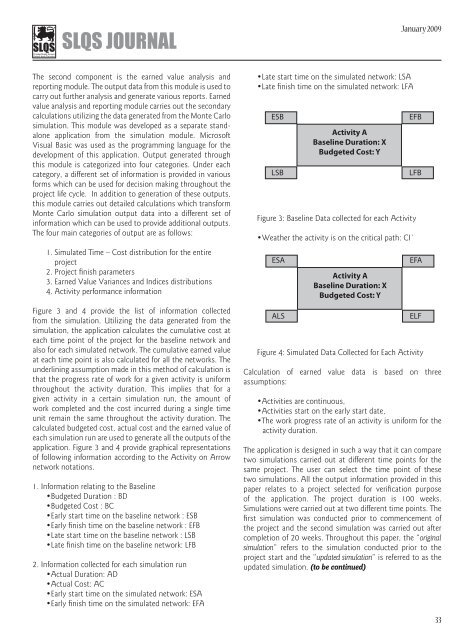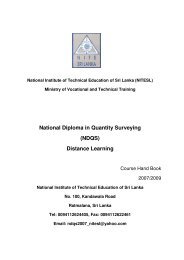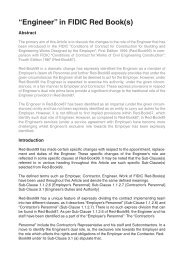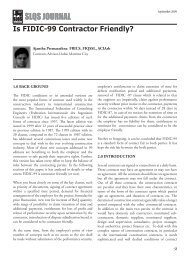SLQS-Journal Vol. 1 - Slqs-uae.org
SLQS-Journal Vol. 1 - Slqs-uae.org
SLQS-Journal Vol. 1 - Slqs-uae.org
You also want an ePaper? Increase the reach of your titles
YUMPU automatically turns print PDFs into web optimized ePapers that Google loves.
<strong>SLQS</strong> JOURNALJanuary 2009The second component is the earned value analysis andreporting module. The output data from this module is used tocarry out further analysis and generate various reports. Earnedvalue analysis and reporting module carries out the secondarycalculations utilizing the data generated from the Monte Carlosimulation. This module was developed as a separate standaloneapplication from the simulation module. MicrosoftVisual Basic was used as the programming language for thedevelopment of this application. Output generated throughthis module is categorized into four categories. Under eachcategory, a different set of information is provided in variousforms which can be used for decision making throughout theproject life cycle. In addition to generation of these outputs,this module carries out detailed calculations which transformMonte Carlo simulation output data into a different set ofinformation which can be used to provide additional outputs.The four main categories of output are as follows:1. Simulated Time – Cost distribution for the entireproject2. Project finish parameters3. Earned Value Variances and Indices distributions4. Activity performance informationFigure 3 and 4 provide the list of information collectedfrom the simulation. Utilizing the data generated from thesimulation, the application calculates the cumulative cost ateach time point of the project for the baseline network andalso for each simulated network. The cumulative earned valueat each time point is also calculated for all the networks. Theunderlining assumption made in this method of calculation isthat the progress rate of work for a given activity is uniformthroughout the activity duration. This implies that for agiven activity in a certain simulation run, the amount ofwork completed and the cost incurred during a single timeunit remain the same throughout the activity duration. Thecalculated budgeted cost, actual cost and the earned value ofeach simulation run are used to generate all the outputs of theapplication. Figure 3 and 4 provide graphical representationsof following information according to the Activity on Arrownetwork notations.1. Information relating to the Baseline•Budgeted Duration : BD•Budgeted Cost : BC•Early start time on the baseline network : ESB•Early finish time on the baseline network : EFB•Late start time on the baseline network : LSB•Late finish time on the baseline network: LFB2. Information collected for each simulation run•Actual Duration: AD•Actual Cost: AC•Early start time on the simulated network: ESA•Early finish time on the simulated network: EFA•Late start time on the simulated network: LSA•Late finish time on the simulated network: LFAESBLSBFigure 3: Baseline Data collected for each Activity•Weather the activity is on the critical path: CI`ESAALSActivity ABaseline Duration: XBudgeted Cost: YActivity ABaseline Duration: XBudgeted Cost: YEFBLFBEFAELFFigure 4: Simulated Data Collected for Each ActivityCalculation of earned value data is based on threeassumptions:•Activities are continuous,•Activities start on the early start date,•The work progress rate of an activity is uniform for theactivity duration.The application is designed in such a way that it can comparetwo simulations carried out at different time points for thesame project. The user can select the time point of thesetwo simulations. All the output information provided in thispaper relates to a project selected for verification purposeof the application. The project duration is 100 weeks.Simulations were carried out at two different time points. Thefirst simulation was conducted prior to commencement ofthe project and the second simulation was carried out aftercompletion of 20 weeks. Throughout this paper, the “originalsimulation” refers to the simulation conducted prior to theproject start and the “updated simulation” is referred to as theupdated simulation. (to be continued)33





